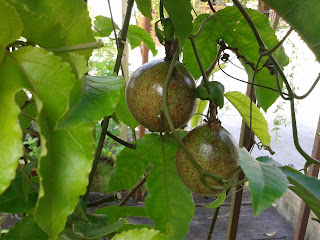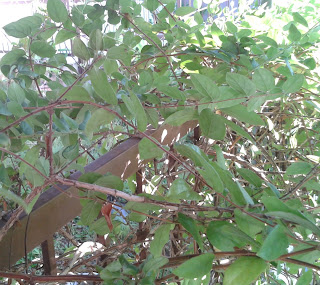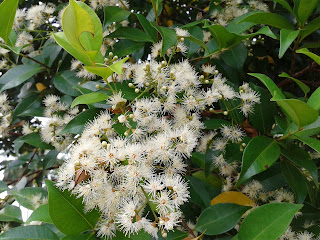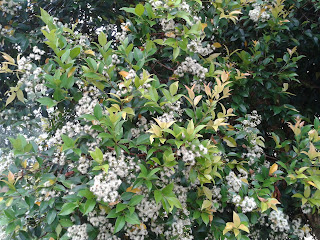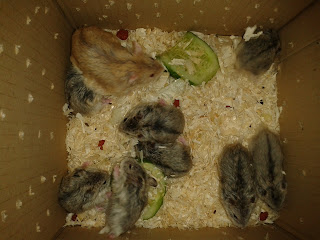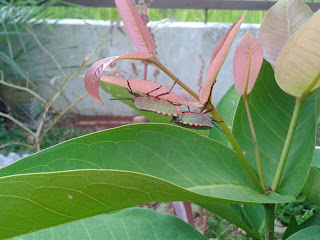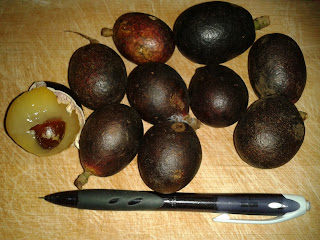Passion fruit / Passiflora edulis / Buah markisa
Describe passion fruit in one word... YUMMY !
Just cut into half and eat it raw by the scoops.
Spike your aqua drink with it.
Spike your ginger infused calamansi drink with it.
Sprinkle onto your yoghurt.
Just eat it as you like it.
Propagate by cuttings or seeds.
Require compost rich, moisture rich soil. Deep rooting, so you will need a deep pot if planting in container.
Passion fruit is a vine; stakes or trellis is needed for support.
Requires nine months to flower when propagated by cuttings.
http://en.wikipedia.org/wiki/Passion_fruit
Fresh passion fruit is high in beta carotene, potassium, and dietary fiber. Passion fruit juice is a good source of ascorbic acid (vitamin C), and good for people who have high blood pressure.[8] Some research is showing that purple passion fruit peel may help with controlling asthma symptoms.[9] The yellow variety is used for juice processing, while the purple variety is sold in fresh fruit markets. The fruit contains Lycopene in the mature and immature pericarp.[10]
Just another small fry scalping for pittance in a sea of sharks. ikan bilis main kupiao was originally to log kupiao matters of interest, but now houses what-not of interest.
Saturday 29 October 2011
Wednesday 26 October 2011
Flora : Japanese Honeysuckle
Japanese Honeysuckle / Lonicera japonica / Jin Yin Hua
Japanese honeysuckle is a hardy perinial once established; will grow in most soil but thrives best in compost rich, well draining soil. It is a creeper, so stakes or trellis is needed for support.
This creeper requires full sun. While it will thrives under partial or full shade, it needs full sun to bloom. Propagated by cuttings, the first bloom will appear only after one year when planted under full sun.
And as its' name sake suggest, the flowers are sweet smelling and rich in nectar.
The flowers are harvested and used for tea infusion with medicinal properties. The tea is good for fever, sore throat and migraine. The flowers can also be dried for later use.
http://en.wikipedia.org/wiki/Lonicera_japonica
The Japanese Honeysuckle flower is of high medicinal value in traditional Chinese medicine, where it is called rěn dōng téng (Chinese: 忍冬藤; literally "winter enduring vine"[citation needed]) or jīn yín huā (Chinese: 金銀花; literally "gold silver flower"). Alternate Chinese names include Er Hua and Shuang Hua.[5] It has antibacterial and anti-inflammatory properties[citation needed], and is used (often in combination with Forsythia suspensa) to dispel heat and remove toxins, including carbuncles, fevers, influenza and ulcers. In Korean, it is called geumeunhwa. The dried leaves are also used in traditional Chinese medicine.
Jin Yin Hua (Japanese Honeysuckle, Flos Lonicerae Japonicae) is notable for its inclusion in the traditional Chinese medicine herbal formula Honeysuckle and Forsythia Powder. In pinyin, this formula is called Yin Qiao San. Traditional indications for use of this formula include fever, headache, cough, thirst, and sore throat.[6] For indications such as this, it is common to find Japanese Honeysuckle paired in Chinese medicine herbal formulations with Forsythia (Lian Qiao, Fructus Forsythiae Suspensae). According to Chinese medicine, these herbs, when combined, have a synergistic medicinal effect to address indications such as fever with headache and sore throat. This is why these two herbs are considered "paired herbs."
In Chinese medicine, Jin Yin Hua is classfied with a temperature property of cold. The cold designation specifically refers to, in this case, to Jin Yin Hua's antitoxin, anti-bacterial, antipyretic, and anti-inflammatory properties.[7] Also, according to traditional Chinese medicine, Jin Yin Hua is contraindicated for patients with medical conditions that are diagnosed as deficient and cold in nature unless combined with other herbs to balance the temperature nature of Jin Yin Hua. In layperson terms, Jin Yin Hua is used in Chinese medicine to address what are called excess heat conditions such as fevers, skin rashes, and sore throat. Excess heat conditions are essentially inflammatory processes involving heat, redness, pain, and swelling often due to external pathogenic factors such as bacteria and viruses. The cold nature of Jin Yin Hua is considered to cool the heat nature of the heat related conditions. For example, Jin Yin Hua's antibacterial properties can help to cool a fever. In this case, the cold herb treats the heat condition. However, should a patient present with what is termed as a cold condition such as aversion to cold with cold limbs, cold and pain in the abdomen, and abdominal pain relieved by warmth,[8] then Jin Yin Hua's cold nature is said to be contraindicated for treating the pre-existing cold condition. Should an herbalist choose to use Jin Yin Hua in an herbal formula for a patient with a cold condition, he/she would then choose to balance the temperature of Jin Yin Hua with another herb that is warming in nature.
Japanese honeysuckle is a hardy perinial once established; will grow in most soil but thrives best in compost rich, well draining soil. It is a creeper, so stakes or trellis is needed for support.
This creeper requires full sun. While it will thrives under partial or full shade, it needs full sun to bloom. Propagated by cuttings, the first bloom will appear only after one year when planted under full sun.
And as its' name sake suggest, the flowers are sweet smelling and rich in nectar.
The flowers are harvested and used for tea infusion with medicinal properties. The tea is good for fever, sore throat and migraine. The flowers can also be dried for later use.
http://en.wikipedia.org/wiki/Lonicera_japonica
The Japanese Honeysuckle flower is of high medicinal value in traditional Chinese medicine, where it is called rěn dōng téng (Chinese: 忍冬藤; literally "winter enduring vine"[citation needed]) or jīn yín huā (Chinese: 金銀花; literally "gold silver flower"). Alternate Chinese names include Er Hua and Shuang Hua.[5] It has antibacterial and anti-inflammatory properties[citation needed], and is used (often in combination with Forsythia suspensa) to dispel heat and remove toxins, including carbuncles, fevers, influenza and ulcers. In Korean, it is called geumeunhwa. The dried leaves are also used in traditional Chinese medicine.
Jin Yin Hua (Japanese Honeysuckle, Flos Lonicerae Japonicae) is notable for its inclusion in the traditional Chinese medicine herbal formula Honeysuckle and Forsythia Powder. In pinyin, this formula is called Yin Qiao San. Traditional indications for use of this formula include fever, headache, cough, thirst, and sore throat.[6] For indications such as this, it is common to find Japanese Honeysuckle paired in Chinese medicine herbal formulations with Forsythia (Lian Qiao, Fructus Forsythiae Suspensae). According to Chinese medicine, these herbs, when combined, have a synergistic medicinal effect to address indications such as fever with headache and sore throat. This is why these two herbs are considered "paired herbs."
In Chinese medicine, Jin Yin Hua is classfied with a temperature property of cold. The cold designation specifically refers to, in this case, to Jin Yin Hua's antitoxin, anti-bacterial, antipyretic, and anti-inflammatory properties.[7] Also, according to traditional Chinese medicine, Jin Yin Hua is contraindicated for patients with medical conditions that are diagnosed as deficient and cold in nature unless combined with other herbs to balance the temperature nature of Jin Yin Hua. In layperson terms, Jin Yin Hua is used in Chinese medicine to address what are called excess heat conditions such as fevers, skin rashes, and sore throat. Excess heat conditions are essentially inflammatory processes involving heat, redness, pain, and swelling often due to external pathogenic factors such as bacteria and viruses. The cold nature of Jin Yin Hua is considered to cool the heat nature of the heat related conditions. For example, Jin Yin Hua's antibacterial properties can help to cool a fever. In this case, the cold herb treats the heat condition. However, should a patient present with what is termed as a cold condition such as aversion to cold with cold limbs, cold and pain in the abdomen, and abdominal pain relieved by warmth,[8] then Jin Yin Hua's cold nature is said to be contraindicated for treating the pre-existing cold condition. Should an herbalist choose to use Jin Yin Hua in an herbal formula for a patient with a cold condition, he/she would then choose to balance the temperature of Jin Yin Hua with another herb that is warming in nature.
Thursday 20 October 2011
Flora : Eugenia
Eugenia plant
First time I saw an eugenia plant blooming profusely. The flowers were sweet smelling.
First time I saw an eugenia plant blooming profusely. The flowers were sweet smelling.
Tuesday 18 October 2011
Sunday 16 October 2011
Watching the day goes by
Yep, if the intention is to discourage people from patronising this mall during weekends, the mall management has sure succeeded.
One big dwarf hamster family... before they are adopted. Russian dwarf.
Man's best friend at a certain open air food court steadfastly waiting for scraps.
Yes, he got a few scraps before moving to the next table.
Butterflies and moths are pleasing to the eyes, but their caterpillars are scourge of every garderner.
A moth laying eggs behind a roselle leaf.
Sharing my satay gravy with a fly.
Fucking stink bugs.
Wednesday 12 October 2011
Flora : Crystal Fruit
Crystal Fruit/ Kasai/ Fijian Longan/ Pometia Pinnata
This is a mildly sweet to sweet tasting fruit with an egg like shell. Just give it a good squeeze along the equator and it will pop open.
The flesh taste like longan and is addictive once you started :)
Warning: Crystal fruit is very heaty, more heaty than rambutan or longan. Young children should consume no more than half a dozen fruits in a day. Even an adult will feel the "heat" if he/she consumes too many fruits.
There are a few commercial species of crystal fruit. Picture below is of purple shell variety. The tree reaches the height of durian trees grown from seed with matching trunk size and lateral root spread. You will need a big vacant plot to plant this purple variety.
The green shell variety is a drawf by comparison. The tree starts to yield after two years from germination, with a trunk girth of no more than a foot, and a height of no more than three meters tall.
This is a mildly sweet to sweet tasting fruit with an egg like shell. Just give it a good squeeze along the equator and it will pop open.
The flesh taste like longan and is addictive once you started :)
Warning: Crystal fruit is very heaty, more heaty than rambutan or longan. Young children should consume no more than half a dozen fruits in a day. Even an adult will feel the "heat" if he/she consumes too many fruits.
There are a few commercial species of crystal fruit. Picture below is of purple shell variety. The tree reaches the height of durian trees grown from seed with matching trunk size and lateral root spread. You will need a big vacant plot to plant this purple variety.
The green shell variety is a drawf by comparison. The tree starts to yield after two years from germination, with a trunk girth of no more than a foot, and a height of no more than three meters tall.
Sunday 9 October 2011
Flora : Wild Strawberry
Wild Strawberry
Grows best in compost rich, well draining soil. Propagates through runners and seeds.
Thrives under partial shade or full shade. Strong sun exposure can scald leaves.
The berries are pinky fingernail size and taste quite bland. You will need to plant a dozen or so crowns to get a decent harvest.
Needs regular pruning of dead leaves, runners and spent fruit stalks to encourage flowering.
You can eat the berries fresh or add them to yogurt or icecream for a bit of colour.
Grows best in compost rich, well draining soil. Propagates through runners and seeds.
Thrives under partial shade or full shade. Strong sun exposure can scald leaves.
The berries are pinky fingernail size and taste quite bland. You will need to plant a dozen or so crowns to get a decent harvest.
Needs regular pruning of dead leaves, runners and spent fruit stalks to encourage flowering.
You can eat the berries fresh or add them to yogurt or icecream for a bit of colour.
Ornamental wild strawberry plant on a rotting tree trunk.
Subscribe to:
Posts (Atom)
